There You are again. I think it’s You. An image of You I have not seen before, but the deep blue veil makes me believe it is You. Only Your face and hands are visible. You are gazing out, one hand reaching forward, the other grasping the folds of Your veil. Something has drawn Your eyes from the pages You are reading. Ah, this portrait of You should grace my altar.
I am in Palermo, Sicily. The shop has prints in three sizes. But I’m sure it would be impossible to get You home in my suitcase undamaged. I decide to think about it. You will be here tomorrow. As I wander the tourist shops, I see that same image of You in pop art and on a wine bottle display but the shop does not carry the wine. Is it indeed You and who rendered this painted image? How do you Google a painting, I wonder?
The next day I am hiking Mt. Etna with my daughter Ariel. “The mountain is called La Montagna,” the volcanologist, Danilo, tells us. “It is the feminine form of the word for mountain. She is considered the Mother. Her black volcanic ash provides this fertile ground.” He chuckles. “But you know sometimes a mother gets angry and explodes. Listen, you can hear her.” Soft boom-booms echo from the craters on the other side. We are fortunate to be here during her little eruptions. She sends a steady plume of steam high up into a cloudless December sky.
Etna’s porous rock crunches underfoot. The melting snow leaves no muddy path—there is no soil, only volcanic grit. I pick up a small chunk of rock and crumble it in my hand. It crushes easily. I am surprised it leaves no sooty residue on my palm.
La Montagna, the Mother Mountain, a black lava Mother, a Black Madonna. You are here with me on this mountain—clean, dark, fertile.
This is the first trip my daughter and I have taken together—just the two of us. It is her fortieth birthday. We have fallen in love with La Montagna. We look out from our hotel window each night. “Look lava!” We can just make out the red lines flowing down the mountain in the distance.
We return home with volcanic pebbles and matching tattoos of La Montagna—a simple drawing of the volcano on the inside of our right wrists with a line of smoke rising from the top and extending around onto our forearm in a decorative flourish.
I do not buy the art print, just Your image on a small magnet.
“I found this at the library.” Just days after my return, my husband hands me a book entitled The Art of Reading: An Illustrated History of Books in Paint, by Jamie Camplin and Maria Ranauro. I open the book and begin to thumb the pages. There You are. The painting from Palermo. The exact image on my magnet. It is indeed You. Virgine Annunziata by Antonello da Messina—his final masterpiece completed in 1476. He has painted You at the moment Your reading is interrupted by the Archangel Gabriel annunciating the birth of Your son.
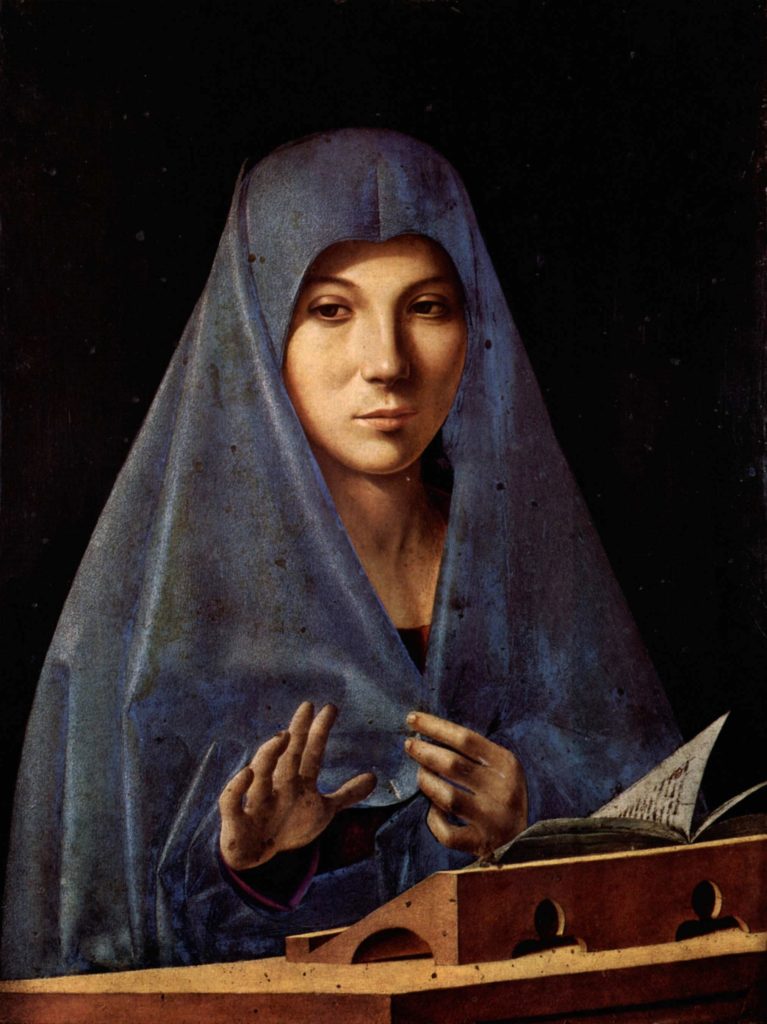
Vergine Annunciata” by Antonello da Messina
I was named for You. One story goes that a family member—I don’t know who—was sick and dying. My mother prayed and promised that if the person lived, she would name her first daughter in Your honor. Or, maybe it was because my paternal grandmother’s name was Maria.
As a good Sicilian Catholic girl, I went to church, received the sacraments, and often fainted in church—not due to visions but from fasting for communion. I loved fingering my white pearly rosary beads, chanting Your prayer on the five sets of ten, mostly skipping over the prayers on the other nine beads. Once I asked my mother if Jesus/God (for I believed them to be one and the same) would be angry if I said my prayers only to You. My mother’s response was one of assurance that I would not be damned.
When I left home for college in 1968, I didn’t make time for church. I had a boyfriend then, who was Catholic so I went to mass with him. When we started having sex, I thought as long as I confessed it and said my penance prayers, it would be cool. So we both confessed but the priest refused us absolution—told us to stop or break up. I broke up with the Catholic Church.
It was the dawn of the New Age. I followed no religious path. In the mid 70’s I went to San Francisco, got high, and began to find spirituality in a place I hadn’t thought to look…within. I took the “Ma” off my name and began to call myself Ria. Maria just seemed too holy for me now. It was fine back in the 50’s while I was a child in my home-place in New Jersey among extended family. When we moved away to Ohio in the mid 60’s and I got into high school, Maria seemed too ethnic and uncool—except for a short time after the movie West Side Story came out. Once I got to the West Coast though, I was out of family range and onto new adventures. I needed an alias.
Over the next ten years, I waded through a variety of doctrines: the teachings of Don Juan, “higher” consciousness handbooks, Yoga, paganism, Native American spirituality, goddess archetypes. I sat in circle with women. We did ceremony, drummed, burned sage, held sweat lodges, and prayed to the goddesses. I wasn’t thinking of You.
You were there though, weren’t You? That day I was at the library searching for a book for my mother by Barbara Taylor Bradford. As I pulled it from the shelf, the book next to it fell to the floor—The Mists of Avalon by Marion Zimmer Bradley. On the cover, a dark-haired woman in a blue robe holding the blade of a sword, point down hilt up, sits upon a gleaming white horse surrounded by mist—a “reimagining of the Arthurian legends.” The story is told through the character of Morgaine, King Arthur’s half-sister. Not the villainess in this rendering, Morgaine is a high priestess, a blue crescent moon tattooed upon her forehead. The mists hide the enchanted isle of Avalon where she leads the women who worship the Great Mother Goddess. There is magic and intrigue and love and heartbreak and all the best parts of a pre-Christian fantasy saga about King Arthur. I wanted a blue crescent moon tattoo on my forehead. But the final scene of the story had the twist that You knew about, didn’t You? The goddess community has been banned by the Christians. Morgaine, as an old woman, takes refuge in the nearby nunnery and finds the women praying before a statue of You. She realizes You are the Christian form of the Goddess.
I was in my 30’s, deep into the Goddess and the Divine Feminine and You were trying to reach me through the fiction I was reading. Fiction that fell off the shelf at my feet. I wasn’t really listening.
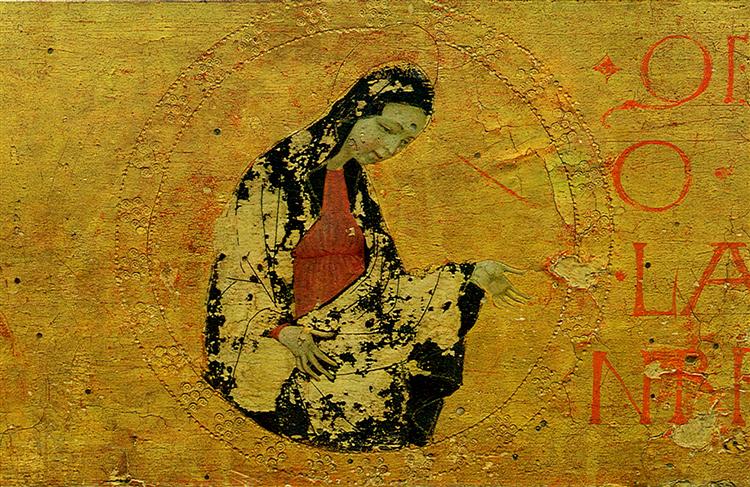
“Madonna” by Paolo Uccello
My devotion to the Divine Feminine continued for a couple of decades before I settled into Buddhism. The philosophy made sense and posed questions at the same time. I had to think for myself, not just align with a stated doctrine. I learned to meditate, took refuge and the Bodhisattva Vow. Buddhism, a practice not a religion, allows for one to continue being Catholic or any other religion and still practice Buddhism. Not an issue for me. I didn’t consider myself Catholic anymore. My teacher joked that Catholics study Tibetan Buddhism rather than Zen Buddhism because of all the chanting and ritual. “It makes them feel at home,” she said. I winced.
Did I consider Catholicism home base? I stepped into Catholic churches only for weddings and funerals. When I attended a Christmas Eve midnight mass in Sorrento, Italy in 2004, it was more a tourist activity than a devotion. Yet I did feel a tug, remembering the midnight masses of my youth.
During my next trip to Italy, in 2015, I happened upon a small chapel in Siena. This is not unusual in Italy. Chapels seem to erupt from every corner. This one was devoted to St. Catherine. It was as beautiful as any chapel I had seen, but I was overwhelmed by the size of the crucifix—Jesus nailed to the cross. It was not only massive but the suffering was uninhibited. I had expected to see more feminine divinity, at least a statue of St. Catherine. There was none. But as I gazed upon Jesus on that crucifix, I thought of You, his mother, and how You must have suffered watching Your son being tortured.
I began to pray as I had learned as a good Catholic girl. Hail Mary, full of grace….
When I got to the part…Holy Mary, Mother of God…I stopped.
Mother of God. What is God? God is Love. Mother of Love?!
Indeed. Mother of Love. And I sobbed. Some fifty years later, here I was looking at Jesus, praying to You with a new understanding.
I started lighting candles to You in every Catholic church I visited. Traveling in Italy provides ample opportunity. My mother was a devotee, lighting a candle by the painting in her bedroom of Madonna and Child every Saturday from noon to 3 pm. She was forced to leave the Catholic Church after she divorced my father, and two more husbands after that. She joined Methodist, Presbyterian, and Lutheran Churches but she never “left” the Catholic Church. Catholicism can have that kind of grip. While she lay dying in hospice, I couldn’t be in the room anymore. I found the chapel and lit a candle to You from noon to 3 pm. I still light candles to You when I visit Catholic churches and chapels—for Mom.
Shortly after my return from that trip to Italy, I had a falling out with the Buddha. While continuing my Buddhist studies, I read a story of how the Buddha’s aunt, the woman who raised him (his mother died shortly after his birth), came to him, with five hundred other women, asking to join his holy order. Buddha refused them. Six times. Eventually he relented and allowed them to become nuns. I was angry with the Buddha. While I embraced his teachings, I could not come to terms with why he would deny women the path to enlightenment. How unenlightened, I thought.
I had been questing the Divine Feminine since I was a child. I decided I needed a holy woman icon for my altar. Which one? Kwan Yin and Tara were possibilities in the Eastern holy traditions. But they were symbolic, maybe even mythical. I’d have to do more research. Then You began to manifest—through no effort on my part. First Clarissa Pinkola Estés honoring You with stories and prayers in her book Untie the Strong Woman. Then a deck of Mother Mary oracle cards someone shared during a writing workshop at the home of a friend. The image on the box of forty-four cards resembled the cover of Estés’ book. I bought the cards the next day. On each card a beautiful painting: Our Lady of Radiant Grace, Our Lady of Becoming, Our Lady of the Dark Mysteries, all with an inspirational message and prayer. Next the novella and play The Testament of Mary by Colin Tóibín and then images of You as the Black Madonna. All of these came to me within a few short weeks. Searching for a wall hanging, I walked into a local art shop/gallery and spotted You as the Lady of Guadalupe. When I told the shop owner my “return to Mary” story, she offered me her painting for whatever price I could pay. I hung You above my altar. I composed Hail Mary prayers leaving out the Jesus parts. I meditated with You. Maybe I am holy enough, I thought.
My devotions and meditations were sporadic at best. It’s easy to miss a day. The trick is to not miss two days. I had good weeks and then life became a distraction and I missed lots of days.
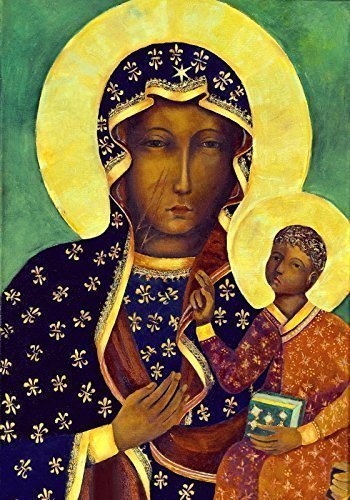
Our Lady of Czestochowa
More than any other figure of the Divine Feminine, You are the one who keeps appearing. You hover near, then step out from behind the veil. Why? Why You? Why not some other goddess—a Greek, Roman, Celtic, Asian, African? I have shelves full of children’s picture books and grown-up texts of the goddesses, artwork on the walls, things I have chosen.
Yet it is You, Mary, who keeps choosing me. You call on me, come unbidden. I wander away but You affix an invisible thread. So that I may find my way back? And You attach another, each new thread holding me close in Your tender embrace.
It’s not that I mind so much. I’m just confused. Why You? Especially since I have forsaken the western faith traditions of Jesus. Is it embedded in the Sicilian DNA code? Like the way it was for my mother?
It’s the mother thing isn’t it? The mother thing. There are other mother goddesses, but You are the Queen Mother of mother goddesses, I suppose.
My mother experience has been a disappointed one. In spite of my contentious relationship with my mother, I longed to be a mother of many children. I don’t remember ever not wanting to be a mother. I knew I could do it better—well, at least differently. I was secretly thrilled the first time I started growing a new life. It was 1970 and I was 20 but unwed. I wanted to keep the child but had no support from the father nor my family in that choice. But the law had just changed. I reluctantly opted to terminate. I still carry that guilt and pain. I didn’t call to You then. If I had, would I have chosen differently? Certainly my life would not be what it is now.
Eight years later, I got another chance. I gave birth to my daughter Ariel in 1978. Determined to forge a bond with her, all things mothering became the focus of my life. Where my mother dictated to me, I made space for Ariel’s choices. Much to my dismay, my husband did not share my vision of a larger family. There were to be no more children. Now the Atlantic Ocean separates me from my only child and her two sons. The heartache of that distance haunts me every moment. Visits involve passports, airports, and overseas transport. Is that my punishment for aborting? Twice I had to let go. Two very different releases—one a painful choice, one inevitable.
The inevitable letting-go—it’s what mothers must do. Not like You had to let go. Or like mothers who have had to let go more tragically. But let go none-the-less. I remember the day I realized I was no longer the first call my daughter would make when there was a challenge to overcome or when she arrived safely at a destination. Her new-found love got those calls. Or the day I stood in her kitchen in London and realized she was a grown woman with a husband and two children first, then, my daughter. She had her own life now, just as I did at her age.
Yet we tether our children, don’t we? To our hearts. As You have me to Yours. An eternal mother’s heart.
Perhaps this happens as we enter our last decades. We look back and wonder what we might reclaim. Are You guiding me to revive my devotion to You? My first goddess? What new blessed mothering might I encounter now? Grandchildren, yes, but is there something else You are envisioning for me?
In Palermo, I made first contact with some distant cousins. I introduced myself as Maria, the r rolling off my tongue. I hadn’t planned to do that—call myself Maria. You were whispering.
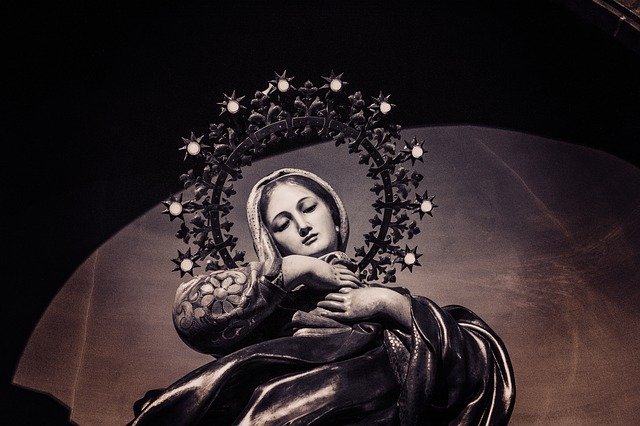

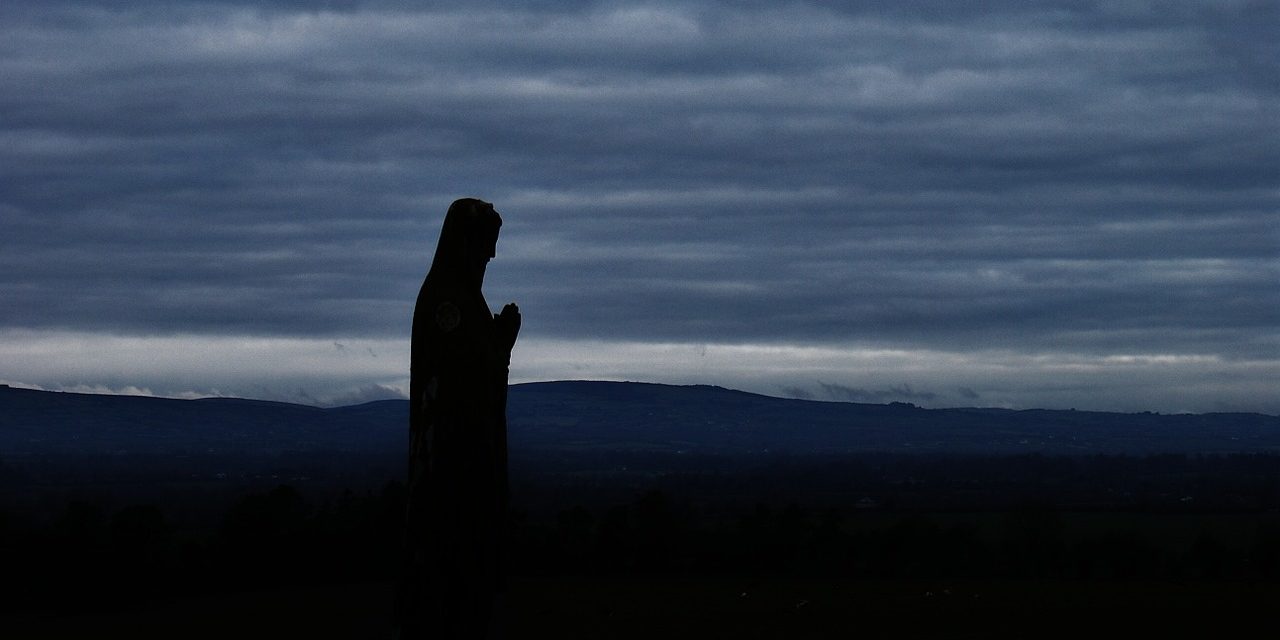
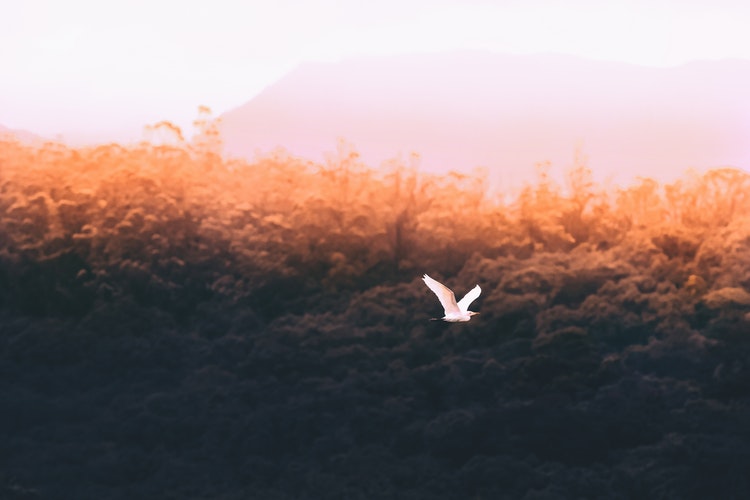
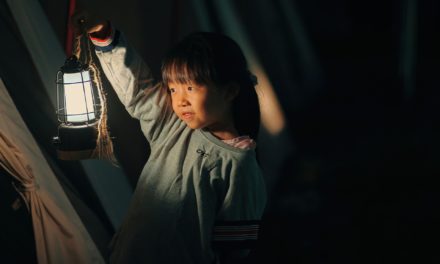

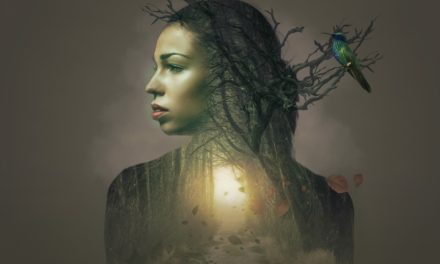

WOW! To the very essence of Maria and Ria, the very raw core, exposed core of who you are and have been. The summation of your life is beautifully written, the veil lifted.
Wow! Wow! Wow! I loved it. So beautiful, haunting, grace filled. It still is whispering within me. Kudos.
Beautiful summary of your life-long search! Wonderful story of your search for the Divine Feminine, an inspiring spiritual teacher and image to contemplate. Thank you for sharing with great depth and openness!
Very heartfelt and touching story. You are brave bad beautiful. Thank you.
An honest and deeply moving transmission of a woman’s journey to herself. I resonate with so many of the explorations. Thank you for putting this into words and sharing it.
Thank you for your story so very much related to mine. I was raised evengelical, converted to catholicism when adult, but left again some 30 tears later because of many things. I then flirted with buddhism … – and now I am just “spiritual”. But throughout my whole journey I have been a true devotee of Mother Mary, daily praying the Rosary. I also do a daily guided meditation on Mother Mary: https://www.youtube.com/watch?v=lSBTVBARoHE.
You wrote “Mary, the Mother of Love”. So true! Thank you.